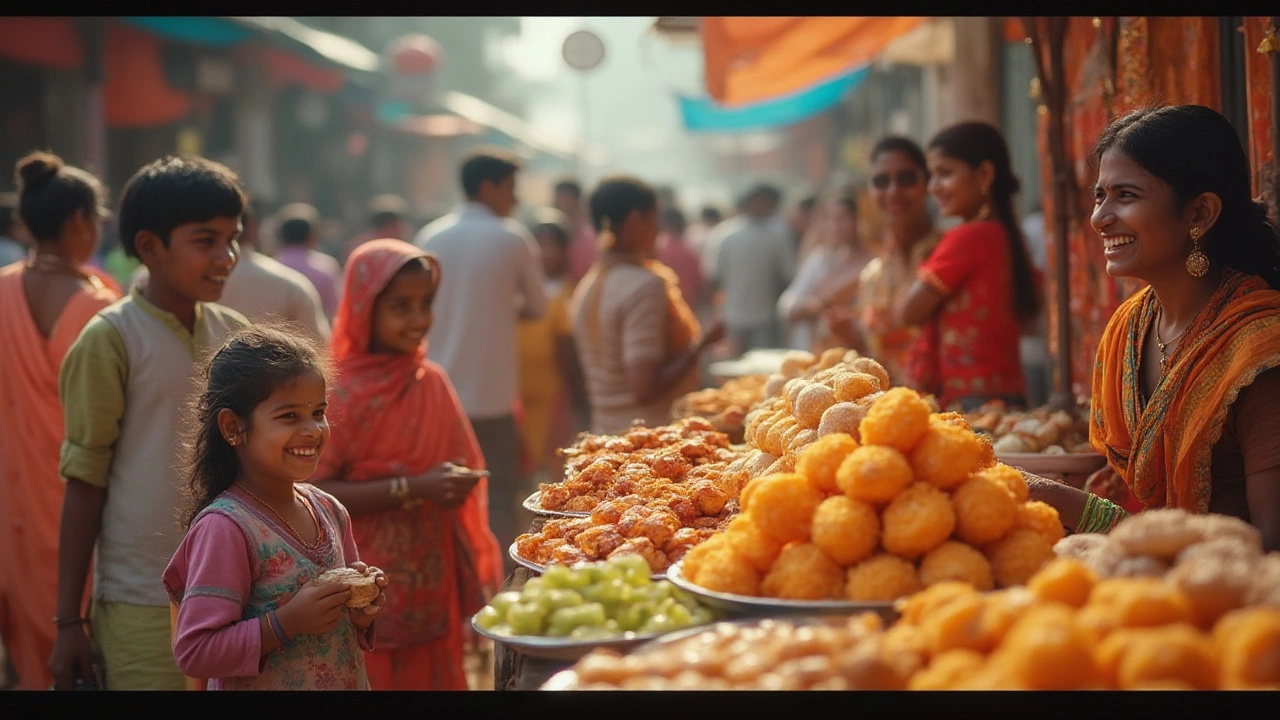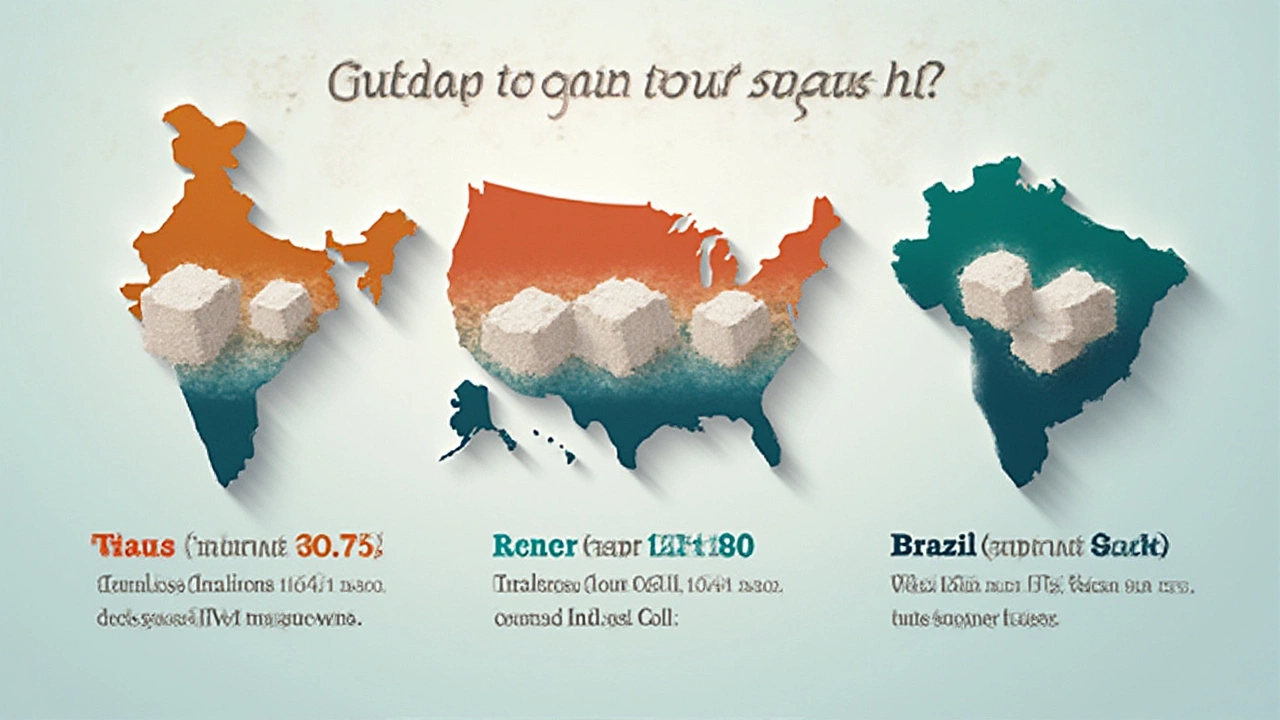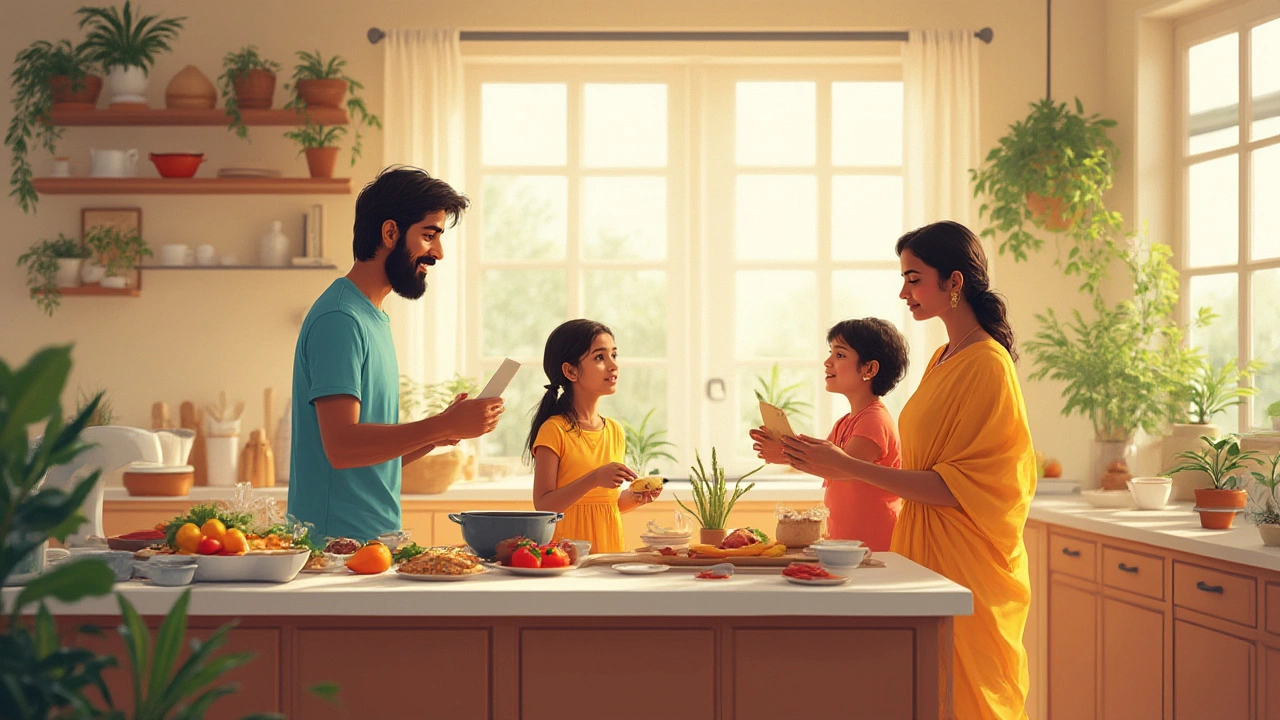Which Country Eats the Most Sugar? Global Sugar Consumption Facts and Health Impacts
 Jul, 26 2025
Jul, 26 2025
Picture a table packed with doughnuts, energy drinks, soft drinks, cakes, jars of Nutella, and candy bars from every corner of the world. Now ask yourself: who’s really eating all this sugar? Turns out, there’s a global tug-of-war going on—while some folks barely touch the sweet stuff, others can’t seem to get enough. The numbers aren’t just wild; they’re downright jaw-dropping, and they say a lot about a country’s culture, habits, and even its food industry’s sneaky tricks.
The Sweet Tooth League: Countries Leading Sugar Consumption
If someone gave out gold medals for sugar guzzling, the USA would probably be on the winner’s podium. According to data from the World Atlas and the World Health Organization not so long ago, Americans average about 126 grams of sugar a day—yep, that’s over 30 teaspoons. Australia trails closely behind, often popping up in the global top ten with a daily average that’s hovered around 100 grams per person in recent years.
Germany and the Netherlands also top the charts. It’s not just about Coca-Cola or donuts; even breads, salad dressings, and those harmless-looking yogurts in these places are laced with sugar. In the UK, the numbers are a bit lower, but not by much—think roughly 95 grams a day. Mexico isn't far off either, with soda consumption being the real culprit. In fact, Mexico has ranked first in per capita soda consumption for years, with Mexicans downing more than 163 liters of soft drinks per year on average.
But here’s a twist—while Western countries often get the most attention, the rise of sugar intake in developing countries is wild. India, for example, is suddenly seeing massive spikes in sugar-sweetened drinks and packaged sweets. China’s sugar consumption has tripled over the past three decades. Pull back, and you’ll notice a global trend—developing nations are catching up fast, thanks to aggressive food marketing and changing diets.
It’s not just a love for desserts or fizzy drinks. Processed foods, instant snacks, energy drinks, even instant noodles can pack hidden sugars. Go to Japan or South Korea and you’ll spot ‘health snacks’ loaded with syrups and sweeteners. Walk through the aisles of a US supermarket—there’s sugar even in salty crackers, bacon, and ketchup. Food labels don’t always make things clear, and sometimes, it's not listed as "sugar" at all—look out for dextrose, fructose, corn syrup, or maltose.
Countries with some of the lowest sugar consumption include China and India (per capita), but their intakes are climbing every single year. African countries like Ethiopia and Nigeria are on the lower end—though that’s mostly due to limited access, not necessarily conscious health choices. If you grew up in Scandinavia, you’d probably have a milder sweet tooth than someone from the US or Australia, but even there, the pull of lollies and soft drinks is real.
Why Do Some Countries Go Overboard with Sugar?
What’s driving people to eat so much sugar? Culture is only half the story. In the US and Australia, the idea of a treat after a meal or a soda with lunch is deeply rooted. Food companies also invest billions into research on making products ‘craveable’. There’s a science to it—our brains are basically hardwired to get a kick from the sweet stuff. You get a dopamine rush, a quick boost of energy, and soon enough, your body is demanding more.
One big reason for overshooting sugar is food processing. In countries like the US and Germany, over 60% of foods sold in supermarkets are considered highly processed. Go grab a ‘healthy’ granola bar in the States, and you might be unknowingly biting into 15-20 grams of sugar. Fruity yogurts, sauces, and breads aren’t as innocent as they look—sugar sneaks in everywhere, making its way into your diet before you know it.
Then there’s price and accessibility. In Mexico, for instance, soft drinks like Coke or Pepsi are sometimes cheaper than bottled water, especially in rural areas. A cold soda is just a standard refreshment, not a rare treat. In fact, a UNICEF study a few years ago showed that some toddlers in Mexico drink more cola than milk daily. It’s a similar story in parts of Southeast Asia where global brands have flooded markets with sugary products that are affordable and heavily advertised—even near schools.
Another reason: aggressive marketing. Remember those classic cola commercials with happy families having fun? That stuff works. Big brands sponsor sports teams, TV shows, even school programs, weaving sugar into daily life. In the US, the average child sees more than 4,000 food ads every year, most of them for junk food or sugary drinks. Countries like Brazil and India are seeing the same patterns emerging. On top of that, the perception of convenience—ready-to-eat snacks, instant drinks, and cafe treats—just make high-sugar options the easiest grab.
It’s also about tradition. Germans love their cakes and pastries, the British can’t resist biscuits with tea, and Australians have a thing for Tim Tams and lamingtons. Even in places like Russia, there’s a strong candy-gifting tradition that’s tough to break. Sweet treats mark birthdays, holidays, and family get-togethers, so reducing sugar can feel like swimming against social current.

Health Fallout: How Sugar Addiction Impacts Populations
Eating too much sugar isn’t just about the odd sugar rush or a few extra kilos on the belt. Countries with sky-high sugar consumption are seeing a real crisis. Type 2 diabetes, heart disease, dental problems, and even some mental health issues have been directly linked to high sugar intake.
Look at America—about 38 million people have diabetes, according to the CDC’s 2024 report. That’s roughly 1 in every 9. Over 96 million have prediabetes. And the biggest environmental factor? Diets loaded with added sugars. The UK and Australia are both facing similar trends. Overweight and obesity rates are soaring, and children are facing a lifetime of health issues before they even graduate primary school.
In Mexico, ongoing studies show that areas with the highest soda intake also have the highest diabetes-related death rates. The Mexican government began slapping a ‘sugar tax’ on sodas and sweetened drinks in 2014. It worked—soda sales dipped a little, but overall, sugary drinks are still hugely popular. In France, where the culture has traditionally valued ‘real food’, the introduction of sugary sodas and snacks has begun to creep into everyday diets, and health officials are watching obesity rates with growing alarm.
One shocking fact: the American Heart Association recently pointed out that eating too much sugar might impact your mood—higher rates of anxiety and depression are linked to diets with lots of added sugars, especially in teens and young adults. Dental experts aren’t surprised either; countries with higher sugar intake see more cavities and gum disease.
The medical consensus is that humans shouldn’t consume more than 25-36 grams of added sugar per day. Most people living in the “sweet tooth league” countries blow past that limit before lunchtime. The heavier health burden is leaving healthcare systems under a ton of pressure, and the cycle keeps going as more sugar finds its way into everyday stuff.
How Sugar Hides in Foods: Spotting the Sneaky Ingredients
If you think you can avoid sugar by steering clear of sweets, you’re in for a surprise. Sugar plays hide-and-seek in all kinds of savoury and processed foods. Check out any supermarket—white bread, BBQ sauce, ketchup, canned soup, breakfast cereal, even frozen veggies sometimes have added sugars for ‘taste enhancement’ or preservation.
Bread in America often tastes sweet because corn syrup or honey is added during baking. In the UK, baked beans can carry up to 9 grams of sugar per serving. Australia’s famous ‘healthy’ cereal brands? Some are as sweet as candy, with over 40% sugar content by weight. In the Netherlands, popular peanut butters often include sugar as the second ingredient.
Reading labels gets tricky when sugar is disguised. Manufacturers use multiple types of sugar—think agave nectar, glucose, fructose, maltose, high-fructose corn syrup. They split these up in the ingredient list to avoid making sugar look like the #1 ingredient, but add up all the different names, and you might get a shock. The average Australian kid, for instance, consumes three times the recommended limit of added sugar, and most of it comes from processed foods, not actual candy.
Even items labeled ‘organic’ or ‘natural’ can pack plenty of sugar. Flavoured yogurts, smoothie packs, and those cute pouches of baby food are big culprits. A strawberry yogurt in Sweden or Germany, for example, can contain up to 15 grams of sugar in a single-serve pot—much more than you’d expect.
Sugar is even used for products you’d never suspect—like salad dressings, ready-made pasta sauces, peanut butter, and instant coffee mixes. For a healthy adult, one burger meal with soda, sauces, and fries in an American fast-food chain can blow past the daily sugar limit with just a single bite and sip.

Realistic Ways to Cut Back—And Fight That Global Sugar Monster
Cutting back on sugar isn’t easy, especially when it’s everywhere. The first step is actually noticing it. Turn into a food detective—read ingredient lists, but don’t just look for ‘sugar’. Watch for high-fructose corn syrup, dextrose, maltose, and honey. If it ends in -ose, keep your guard up.
- Opt for whole foods over processed ones. When you cook your own meals, you control exactly what goes in. Even sauces, dressings, and snacks can be sugar-free when homemade.
- If you shop for breakfast cereal or snacks, go for options with no more than 5 grams of sugar per serving, and make fiber your friend. The higher the fiber and protein, the less likely you’ll face a sugar crash later on.
- Don’t get tricked by ‘no added sugar’ labels. Sometimes, companies use artificial sweeteners that can mess with cravings or include fruit concentrates that are still high in sugar.
- Swap out soft drinks or juices for water, sparkling water, or unsweetened tea. Even so-called ‘healthy’ juices can sneak in as much sugar as a soda.
- Cut down slowly. If you suddenly try to go sugar-free, you’ll feel it. Gradually reduce sugar in tea or coffee, trade soda for water a few times a week, and save the sweet treats for weekends or special occasions.
- If cravings strike, go for whole fruit. Apples, berries, and bananas satisfy a sweet tooth way better than a candy bar, slow the sugar release, and come with vitamins and fiber.
- Get your family or housemates on board. It’s way easier to eat less sugar when your pantry isn’t filled with temptation and you’re not the only one snacking differently.
Different countries are also rolling out policy moves to help. The UK and Mexico both introduced soda taxes to discourage buying sugary drinks. Some US cities have banned junk food ads on public transport. Singapore labels sugary drinks with a red “unhealthy” rating right on the bottle.
In the end, knowing where your sugar comes from puts you in control. Whether you’re munching on Aussie Tim Tams or sipping on sweet iced tea in Texas, remember—just because sugar is everywhere doesn’t mean it should run your day. That gold medal for sugar consumption? Best left on someone else’s table.
